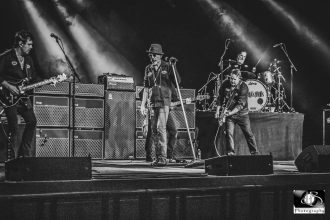Unlock the Editor’s Digest for free
Roula Khalaf, Editor of the FT, selects her favourite stories in this weekly newsletter.
Sam Bankman-Fried’s crypto empire was a “pyramid of deceit” that masked a scheme to steal billions of dollars from customers of his FTX exchange, US prosecutors alleged in the closing arguments of the former mogul’s criminal trial in New York.
Pointing theatrically to the 31-year-old defendant on Wednesday morning, assistant US attorney Nick Roos said, “this man, Samuel Bankman-Fried” was responsible for raiding FTX depositors’ accounts to make a series of risky bets, repay loans and buy real estate.
“He spent customers’ money and he lied about it,” Roos added, maintaining that Bankman-Fried and his company claimed to be the “safest and easiest way to buy cryptocurrencies” in advertising campaigns featuring celebrities Larry David and Tom Brady.
The remarks came at the end of five weeks of testimony that shone a light on the inner workings of FTX, which collapsed last November with an $8bn hole in its balance sheet. Bankman-Fried has pleaded not guilty to the charges against him, which include fraud and money laundering, and potentially faces decades in prison if convicted.
The 12-person jury heard from former executives at the exchange and its affiliated hedge fund Alameda Research, including co-operating witnesses Caroline Ellison, Gary Wang and Nishad Singh. They pointed the finger at Bankman-Fried, alleging that he had instructed them to allow up to $65bn of FTX customer funds to be secretly raided.
Bankman-Fried took the stand and claimed under oath that he had first learned about the misappropriation of the money a month before FTX’s collapse. He spent much of his testimony suggesting that complex trading strategies made it impossible for any one person to be fully abreast of FTX and Alameda’s risk management.
In his closing remarks, Roos sought to rubbish such claims. “This is not about complicated issues of cryptocurrency, not about hedging . . . it’s about lies, it’s about stealing, it’s about greed,” he told the court. “He took the money, he knew it was wrong, and he did it anyway.”
Bankman-Fried, he claimed, “thought he could talk his way out of this”, emphasising that the former billionaire “didn’t have to testify in this trial” but “told a story [and] lied to you”.
Roos said that while the defendant was fluent when questioned by his own lawyer, “he was a different person” on cross-examination and “couldn’t remember a single detail” about the alleged scheme, claiming some 140 times that he could not recall specifics.
“He approached every question like up was down and down was up,” Roos added.
The prosecutor pointed to evidence presented during the government’s case, including “secret spreadsheets” prepared by Ellison with alternative balance sheets to be provided to investors that disguised the extent of use of FTX customer funds, and the establishment of a line of credit for Alameda that allowed it to do “unlimited stealing”.
Roos further argued that in order to believe Bankman-Fried’s version of events — that he was running two successful business but was blindsided by a downturn in the cryptocurrency markets and a smear campaign by competitor Binance, “you would have to believe that the defendant . . . who graduated from [the Massachusetts Institute of Technology] . . . was actually clueless”.
Ellison, Wang and Singh, all of whom have pleaded guilty to fraud, contradicted Bankman-Fried’s narrative, Roos said, reminding the jury that “if you believe even one of these witnesses is telling the truth . . . the defendant is guilty”.
Bankman-Fried’s lawyers are expected to deliver their final arguments later on Wednesday. The jury will begin deliberations after both sides have finished.
Read the full article here




